-
Paper Information
- Paper Submission
-
Journal Information
- About This Journal
- Editorial Board
- Current Issue
- Archive
- Author Guidelines
- Contact Us
International Journal of Arts
p-ISSN: 2168-4995 e-ISSN: 2168-5002
2018; 8(1): 13-19
doi:10.5923/j.arts.20180801.02

Manifestation of “Flower and Vase” Pattern in Iran's Islamic Tiling (with Emphasis on Razavi Holy Shrine)
Sahar Changiz1, Hasan Bolkhari Ghehi2
1Department of Islamic Art and Humanities, Imam Reza International University, Mashhad, Iran
2Department of Fine Arts, University of Tehran, Iran
Correspondence to: Sahar Changiz, Department of Islamic Art and Humanities, Imam Reza International University, Mashhad, Iran.
| Email: |  |
Copyright © 2018 Scientific & Academic Publishing. All Rights Reserved.
This work is licensed under the Creative Commons Attribution International License (CC BY).
http://creativecommons.org/licenses/by/4.0/

In the Iranian traditional design, there is a variety of decorative designs whose original foundation is not based on mere decorations and carries a rich history of the past. One of these designs is “Vase” or “Flower and Vase,” whose manifestation can be seen in a variety of different types of traditional Iranian art. Of the molds, which have been the hallmark of this design, one can mention the design of carpets and decorations related to architecture (stucco, tiling, etc.). This design—as a main pattern—embodied on the body of Islamic buildings in the form of a tile-shaped pattern is nothing but a picture of a vase with plant branches when looked superficially. However, with a deeper analysis one can achieve the main features of it which are rooted in pre-Islamic symbols. The research analyzed the main components of the vase design and achieved “Water, Vase, and Plant,” which greatly coincide with the presence of these elements in the pre-Islamic residual works. Also, the research analyzed the frequent design of the two leaves on both sides of the flower as an ancient pattern.
Keywords: “Flower and Vase” design, “Cup-water-plant” symbols, Islamic tiling, Razavi Holy Shrine
Cite this paper: Sahar Changiz, Hasan Bolkhari Ghehi, Manifestation of “Flower and Vase” Pattern in Iran's Islamic Tiling (with Emphasis on Razavi Holy Shrine), International Journal of Arts, Vol. 8 No. 1, 2018, pp. 13-19. doi: 10.5923/j.arts.20180801.02.
Article Outline
1. Introduction
- In categorization of Iranian carpet designs, “Flower and Vase” is considered to be one of the most popular and diverse patterns. Experts have used indices to classify and examine it among other carpet designs (not much though). However, no specific categorization has been done in architectural decorations—except that they can be placed under the herbal designs. Hence, it would be difficult to name its types. Tiling is one of the important types of Islamic art. It turned into one of the main components of Islamic architecture decoration in Iran’s Timurid, Safavid and Qajar periods in important and especially sacred buildings. Imam Reza (AS) Holy Shrine in Mashhad is one of such buildings which has provided a space for the creation of “flower designs” in tiling. By examining and further studying this decorative pattern, one can find its latent implications—which, due to the lack of attention, have remained as a decorative design only. The study is an attempt to investigate the latent mystery and symbolism of such designs in this sacred place.
2. Tiling of Razavi Holy Shrine
- One of the most prominent examples of these holy places in Iran is the Holy Shrine of Imam Reza (AS), a vast collection of old and new monuments spread around his resting place during twelve centuries. This collection should be considered as a great treasure of Islamic art and solid history of Iranian Islamic architecture. Among the bulk of its artwork, decorations related to architecture, and especially the traditional tile art, are of great importance. The best examples of Islamic tiling for various periods are available in the shrine collection. The historical course of this art can be started from the tiles around the sacred resting place and Goharshad Mosque—representing the tiling of the Timurid period—and reached to the Safavid period tiles, Qajar period tiles and the tiles after the Islamic Revolution. Tiling designs and decorations can be placed in three general categories of plant (plant-animal), geometric (geometric-plant) and inscriptions.
3. “Flower and Vase” Designs in the Tiles of Razavi Holy Shrine
- The vase design is one of the most important designs used in Islamic tiling. In the holy shrine also, it appears to be one of the most popular designs among plant designs. The design is mainly designed in vertical boxes and connects the wall space from top to bottom. In drawing the flower and vase design, mainly an urn or cup is designed. In some instances, instead of which, a form of small Toranj or Shamse1 is used. In the outer space of Goharshad Mosque, Khataeis2 and small flowers in the twist of arabesque3 spins, spread out of the urn and vase Toranjes, are magnificent. Vase designs are mainly applied at the lower levels of the walls, creating beautiful combinations in space arrangement. Picture 1 presents one of these designs recognizable in the entrance to the north Iwan of Goharshad Mosque. The design is also apparent in the Safavid period in outer spaces, and especially in the interior spaces of “Allahverdi Khan Dome.”4 In some instances, the sides of the vase design flaunt themselves. They are mainly the design of two birds or creatures, often a dragon head (Pic. 2). Picture 3 presents three Toranjes on one another—made from the blend of arabesques—completely covered by birds, small arabesque, and Khataei flowers and leaves in the surrounding area. The type of design in Toranjes5 is such that it provokes the form of a vase when viewed in a sense. “The combination of these Toranjes has also been used to decorate the initial pages of the Qur’ans” [18, p. 179]. Picture 4 presents a voluminous and prominent vase of the Safavid period in which the decorative grooves are moving upwardly from inside the vase as a plant going out, connecting the corner of Iwan6 to the adjacent corner and another vase.
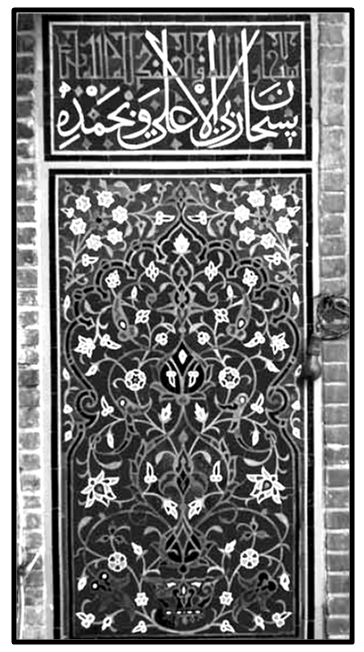 | Picture 1. Entrance to the north Iwan, Goharshad Mosque |
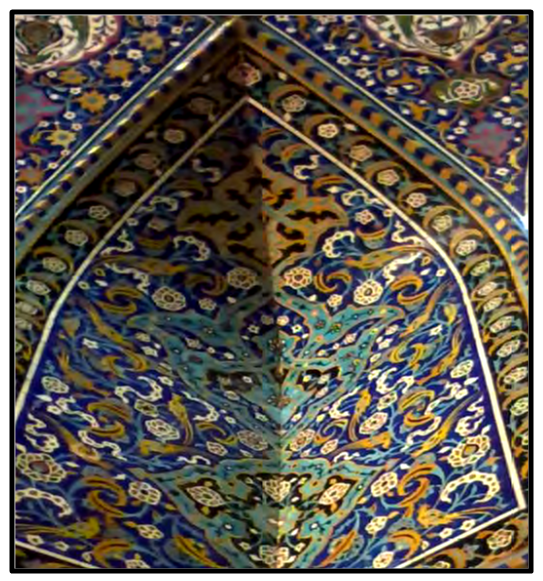 | Picture 2. The combination of the vase design and associated birds; Allahverdi Khan Dome, Safavid period |
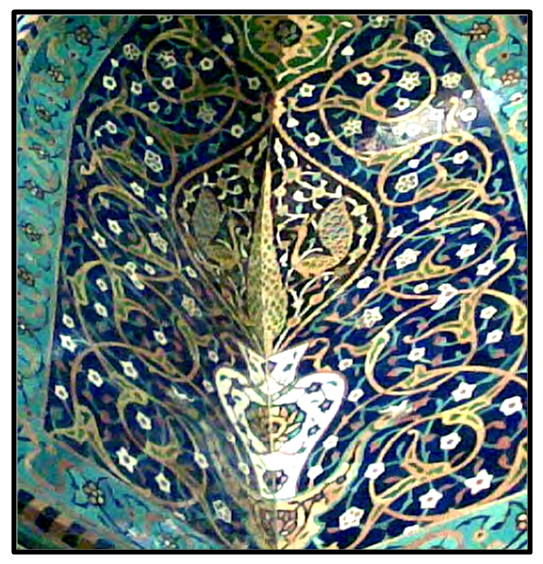 | Picture 3. The combination of 3 Toranjes with arabesque and birds; Allahverdi Khan Dome, Safavid period |
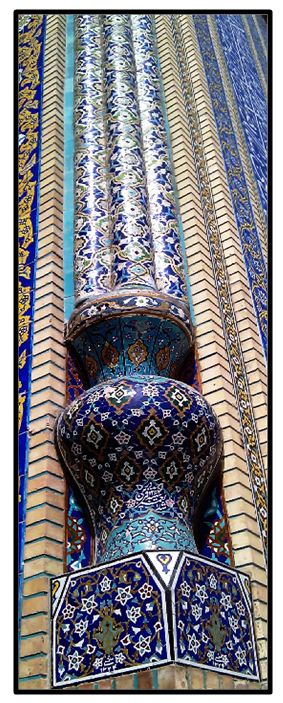 | Picture 4. The prominent vase design; Razavi Holy Shrine, Safavid period |
 | Picture 5. Vase design; the south Iwan of Razavi Holy Shrine, Qajar period (Astan Quds Artistic Creation Center) |
4. Symbolic Analysis of “Flower and Vase” Design
- Since the symbolic roots of this design have not been discussed in a specialized way, and the vase design is merely introduced as a decorative design, the study deals with its semantic roots. By analyzing the main elements used in a flower-and-vase design, it would be possible to reach the “vase-plant” combination code. In the same sense, one can get into the image patterns of the ancient times with searching in Iran’s artwork. Among the pre-Islamic visual and documentary examples in Iran, the image design of the “Cup” is one of the repetitive image patterns, mostly driven out of water, streams of water flow, trees and flowers. On this basis, the “water” code can also come along the “vase-plant” combination code to continue the topic of vase design symbolic analysis with the new “cup-water-plant” pattern. Therefore, it is necessary to do a symbolic analysis on each of these coded combinations so that their semantic relation with the discussed design can be obtained.
4.1. The Symbolic Concept of “Cup”
- Once pursued in ancient times, the root of the “cup-water-plant” code comes to repetitive patterns in Mesopotamian8 art, especially after Gudea’s era of governance. One of these examples is a volumetric figure of Gudea holding a cup from which the streams of water flow down (Pic. 6). The pattern is also seen on the seals left from this era. Since some historians and researchers have identified “Iran,” especially the northern part of Iran’s plateau and the present-day Gilan [11, p. 611-620] as the historical and geographical origin of Mesopotamian civilization, and in particular Sumer, one can use hermeneutics to bring the “cup-water-plant” pattern to one of its earliest origins, Mesopotamia (Pic. 7).
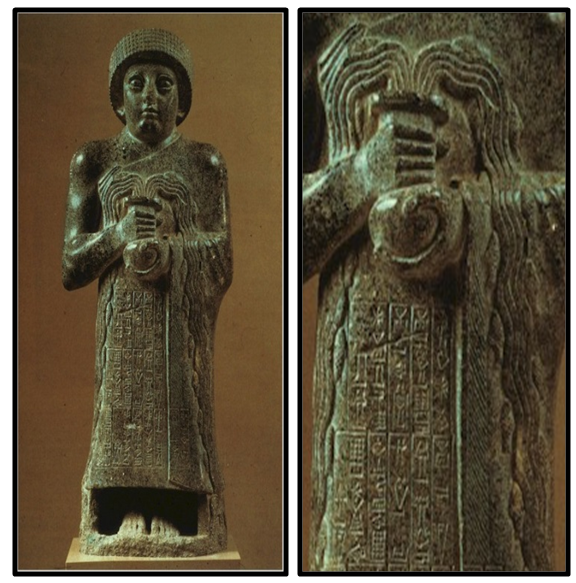 | Picture 6. Gudea and the cup of water flow streams, Mesopotamia |
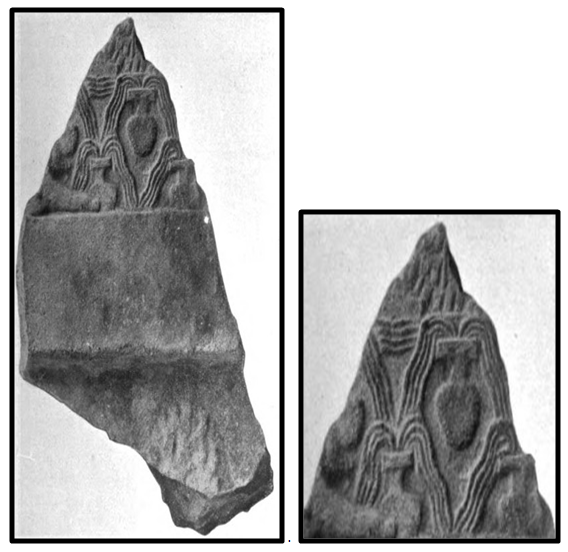 | Picture 7. Fragment of limestone sculptured in relief with vases from which streams of water flow. [3, No. 95477] |
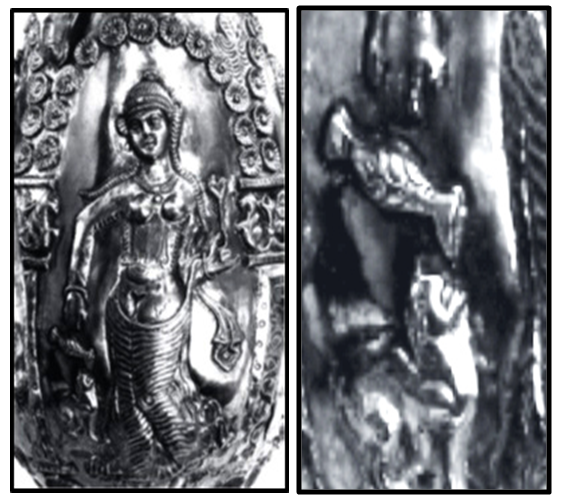 | Picture 8. Nahid with a lotus in one hand and urn in another [19, P. 176] |
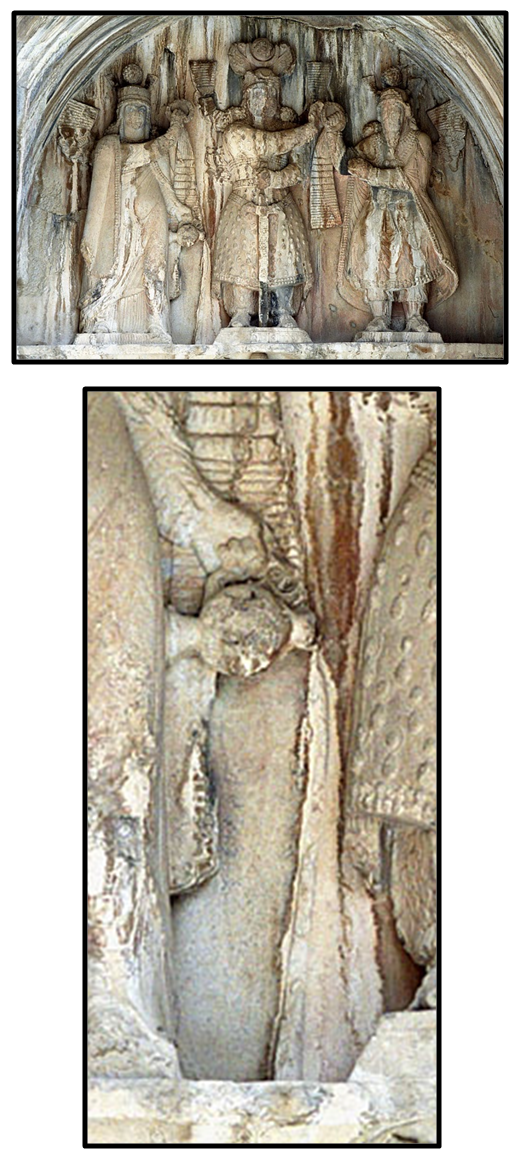 | Picture 9. Khosrow II along with Ahuramazda and Anahita (with an urn); Sasanian period, Taq-e- Bostan |
4.2. The Symbolic Concept of “Water”
- Water is considered sacred in all religions and is the source of the whole world [7]. Similar to the ancient Sumerian worldview, in Iran also water has been considered to be the source of all beings and beliefs based on the creation role of water in the world system since old times [20, p. 96]. Basically, the special function of water is the same in all religions, including disintegration, washing away sins, purification and revival [7, p. 208]. In Hinduism, water is the cause of the emergence of life [2, p. 26], and the creation of the universe from water is a place for the growth of the cosmic tree—which has come out from Narayana’s navel—which in some traditions, the lotus flower, where Brahma was born, has replaced the tree [2, p. 191]. The center of the navel, mouth, throat, snail and cup are the means for the emergence of the cosmic tree, vegetation, and the universe and cosmos themselves. In Iran, the followers of Mehr religion believed that the mother of Mehr (Nahid) was fertilized in water, and they have recreated her childbirth from within the lotus buds [17, p. 94-95]. On this basis, water is the second symbol associated with Mehr rituals [14, p. 45]. In Zoroastrianism, it had two guardians [1, 51-52] which were also associated with the lotus flower [2, ibid], going with the names “ApamNapat,” and the other being Anahita or Nahid with the full name “ArdwisurAnahid” [1, ibid].
4.3. The Symbolic Concept of “Plant”
- It is because of the connection of the themes of flower, water, plant and women that God appears in the creation of the universe simultaneously with the universe and through the flow of the lotus flower floating on the water. In Hindu-Iranian concepts, the instance of this appearance in existence is the miraculous plant of “Soma” [7, p. 272], which is called White Haoma in Iran (the same tree of life) [4, p. 119]. In Rigveda, Soma is an intoxicant that is sometimes manifested like a spring or a stream, and grows like a Heavenly plant, often in the springs of Heavenly waters like a vase with a stream of water flowing on a mysterious island or holy mountain [13, p. 26]. Also, in some texts, both Haoma and Soma are located inside a container, flowing out of which; and from the perspective of the symbolism, they are the source of life, fertility and revitalization, as is the case with the water and plants secret. So these two holy plants have a dual structure in which they are both water and vegetable, and they can evoke the “water-tree” combination, that is, a symbol on the river Javid (the river that revives, is revived and rejuvenated, and flows next to the backup tree). Moreover, the secret source of both of them is in the sky, as the objective essence, or at least the prototype of all the life-giving drinks that give rise to the immortality—White Haoma, Soma, the Honey of the Gods, and so on—are in the sky. [7, p. 272].
4.4. The Symbolic Concept of “Flower and Vase” in the Islamic Era
- “The birth of man from the earth is a universal belief. This deep feeling of getting out of the earth and being born from it is like the inexhaustible fertility of the earth and giving life to elements of life such as tree, flower, grass and river” [7, p. 162]. In this regard, the vase design, sometimes similar to that of an ancient time on a mountain or a triangular form, repeats itself in a similar pattern during Islamic times (Pictures 10 and 11). It can be said that this design is an effective pattern from past civilizations and has a 3,000-year process in its evolutionary course. Of the oldest combinations of this design is the combination of the cypress inside the vase, where the vase is the symbol of the earth as the center of gravity, and the cypress is symbolically placed within it [6, p. 136]. The cypress itself is the same tree of life that is located in the axis of the universe, linking the heaven, the earth and the underlying world (hell) as a mediator, and that has an eastern origin in Mesopotamia and ancient Iran [7, p. 287]. Picture 10 shows a striking feature of the combination of the cypress inside the vase, depicting the tiling of the Great Mosque of Herat during the Timurid era.
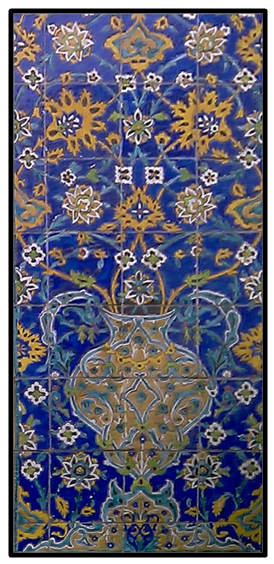 | Picture 10. Vase design in the tiling of the Great Mosque of Herat, Timurid era |
 | Picture 11. Vase design in the entrance to the Iwan of the Safavid period, Holy Shrine |
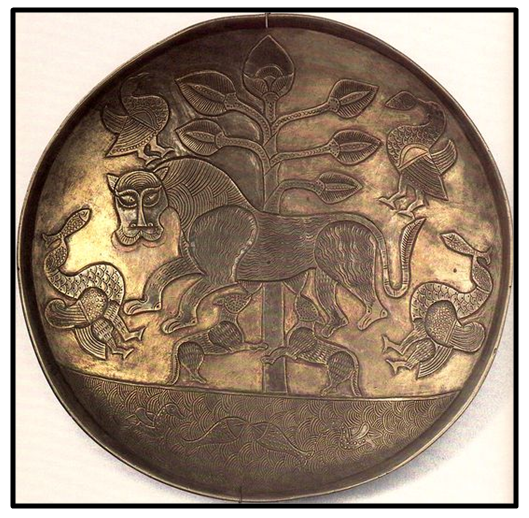 | Picture 12. A container of Sassanian period with a lion in the middle and two fishes (Mahi-Dar-Ham design) [12] |
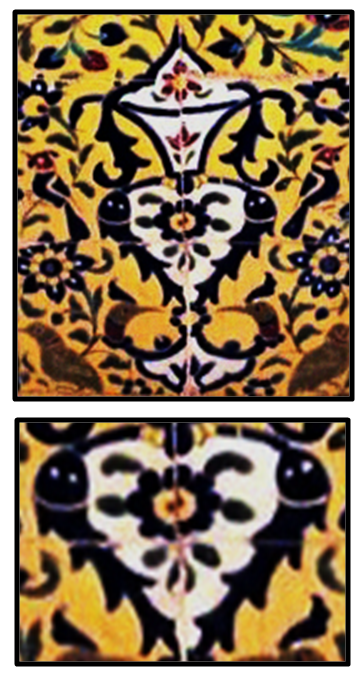 | Picture 13. The vase design with Mixed Fish signs; Agha Bozorg Mosque and School, Kashan |
5. Conclusions
- Considering that the artist of the Islamic era could have started drawing plant branches from the very surface of the earth—instead of using the form of a vase, mountain, etc.—(there are examples of this, of course), an intermediate form has been used for connecting the earth to the sky. The connection seems to have been made through a staircase and an intermediate, which is what has been described by ancient times and among the ancient religions—which, according to Mircea Eliade, they have also been holy—to represent the manifestation of water and vegetation. Accordingly, the authors believe that the vase design used in the Islamic era is the same streams-of-water-flow cup which has been in the hands of Iran’s ancient gods and goddesses, with its religious burden being transferred from one religion to another over time. Being put from another angle, as one can recognize God with his natural manifestations in existence, as his appearances, in every sacred art, the primary elements of manifestation of the essence of God must be present together as well. This view can be seen in the architecture of a mosque as a sacred space, and reached to smaller sections such as the architectural decoration of this holy space. It can even go beyond that and see the entire existence in the form of a vase or cup, as a vase contains water—a code for the principle of creation—and when it overflows, it represents the sea and the waters of the whole world. Moreover, the lid, sometimes above the cup or vase, is also a symbol of the mountain and dome—a code on the center of the universe. Thus, the water-plant-cup code can be found by summarizing, detailing and reaching the root and the source of motifs. It has been flown in the course of the history of all religions, and the most important difference and change in the Islamic era is that of its natural form and nature being transformed into forms with more sophisticated arabesque and Khataei decorations.
Notes
- 1. A decorative design taken from the whole form of the sun and associated with Islamic art special decorations.2. A special decoration in Islamic art. Plant branches in-between arabesques.3. Decorations derived from plant forms that are the invention of the Muslims. Aka “Eslimi,” coming from “Islamic.”4. One of the Safavid ministers in Iran.5. Ardeshir Takestani refers to these Toranjes as small Shamse [18, p. 179].6. Or Ivan.7. In Iran, “Farang” refers to Europe or the Western world.8. This territory is located in the west of Asia, and between the Tigris and Euphrates rivers, in the form of a triangle with parts of Turkey, Syria, Iraq and Iran inside it [16].9. A term for two fish on either side of a human or animal design. This pattern is one of the most important designs in Iran’s carpet design and architectural decorations.
 Abstract
Abstract Reference
Reference Full-Text PDF
Full-Text PDF Full-text HTML
Full-text HTML